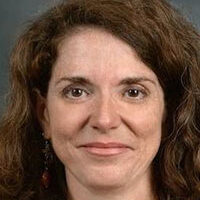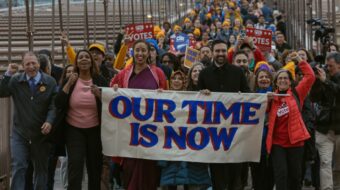
PWW Editor Teresa Albano is blogging from India, where she attended the conventions of the Communist Party of India and Communist Party of India (Marxist). The parties hold seats in the national Parliament and lead the governments in three of India’s states.
COIMBATORE, India — West Bengal Chief Minister Buddhadeb Bhattacharya is a leader of the Communist Party of India (Marxist) and attended the party’s 19th Congress here in the South Indian state of Tamil Nadu.
Bhattacharya took time from his busy schedule for a People’s Weekly World interview.
West Bengal is home to some 80.2 million people and its capital, Kolkata (Calcutta), is one of India’s largest cities.
It is also a state that has been led by a Communist/Left Front government for the past 30 years.
‘I like to say we were voted to power, we didn’t capture power,’ said Bhattacharya. The state’s former chief minister, Jyoti Basu, was a founder of the CPI(M).
Thirty years of reelecting left-led governments makes West Bengal a unique world experience of Communists in power within the framework of a capitalist/landlord system.
‘I firmly believe in the inevitablity of socialism,’ Bhattacharya said. ‘Capitalism is not the last chapter of human history.’
But as elected officials Bhattacharya and his party and their partners in the Left Front also ‘do not ignore but accept reality.’ This means they have to deliver a better standard of living for their people within a national framework that is capitalist-oriented and dominated by large landowners.
Outlining the accomplishments of the left government over the last 30 years, one can understand why they were reelected seven times. The last time, in 2006, the Left Front increased its majority. It now holds 235 seats out of 294 in the state assembly, or three-fourths.
Out of the 235 seats, the CPI(M) holds 178.
‘Radical land reform has been one of our major successes,’ Bhattacharya said. ‘The struggle for a just land distribution changed the coalition of forces in the state.’ He was referring to the Communists and farmers who demonstrated and sometimes forcefully occupied the land and helped propel the left into political power so they could implement further reform.
‘One of the government’s first acts was to give deeds to all the poor farmers (peasants) to prove they owned their acreage,’ he said. Deeds were given in both the husband’s and wife’s names. ‘We didn’t impose gender discrimination in property ownership.’
There are no big landowners in the state, the chief minister said.
A chief minister is equivalent to a U.S. governor.
There is certainly state power for the left here, but it is limited by the overall balance of forces in India.
Another reform the left, farmers and workers created in Wes Bengal is the implementation of local governments, called panchayats, throughout the rural areas and the state. This local government means farmers and village people have a say themselves in the development of their areas. ‘Thirty percent of the leadership of these panchayats are women, and they are vibrant especially in the rural areas,’ Bhattacharya said.
As a result of land reform, production of rice, vegetables and fish has increased. West Bengal is self-sufficient in these areas and can export its products. The poverty rate is the lowest in the country. According to the official figures 38 percent of India’s population falls below the national poverty line. In West Bengal it is 27 percent, down from 56 percent.
‘Our main challenge now is how to improve the quality of life and purchasing power of farmers and workers and those who are still in poverty,’ he said.
That means, for the government, that capital investment has to be pursued. But how it chooses to pursue investment is a political question. At the CPI(M) congress and in its political resolution, much attention was given to these and related issues. The CPI(M) leads governments in two other states as well: Tripura — in the northeast as is West Bengal — and Kerala in the southwest.
‘We seek capital investment on a mutual basis. Companies are looking to make a profit and we are looking to provide jobs so people can improve their lives. Companies must follow the labor and environmental laws of the land,’ Bhattacharya said.
‘This is investment based on mutual interest. West Bengal is a huge market — 80 million people.’
The left government has also invested heavily in human resources, mostly in education and health care. West Bengal has one of the highest rates of English speakers in India, something the government points out to many U.S.-based and other corporations.
West Bengal was the first state in the country to provide primary school education (grades 1-5) completely free with teachers receiving a decent salary. ‘We also provide free meals and books to the students. Children cannot learn if they are hungry,” Bhattacharya said. ‘Our target is 100 percent participation in these schools. We estimate there are still 500,000 poor children not going to school but we are confident that in the next three to five years we will have all children in school.’
Universal and free health care is also a goal for the left government. There are five types of medical care in West Bengal, from clinics to hospitals in both urban and rural settings. The chief minister estimated that about 70 percent of the rural areas are covered with some form of care.
‘We get funds from the World Bank to help cover this medical program. But we tell them ‘no conditions.’ We’ll pay back the loan in two or three years, but you can’t tell us how to staff the hospitals or how many doctors should be hired. That’s up to us,’ Bhattacharya said.
West Bengal’s infant mortality rate — a telling indicator of the quality of any country’s health care system — is one of the lowest in the country: 7 in 1,000.
University and vocational training, especially in computers, is growing in the state. There are 612 colleges, many of them engineering schools, and 17 universities that teach medicine, other science and technology, managing animal resources, etc. The state is investing in modernizing its agriculture while at the same time embarking on building industry.
There are other challenges the West Bengal government faces. ‘When you have your [national] government at the center following one policy of liberalizing capital investment, there are challenges for the states,” Bhattacharya said. “Foreign trade is in the hands of the central government.’
Most recently the West Bengal government has instituted a pension plan for unorganized workers, who make up about 90 percent of the state’s (and country’s) workforce. The state also gives a special grant when workers are laid off and a factory is closed.
West Bengal attracted the U.S. corporate media last year during an intense struggle in the small town of Nandigram. Bhattacharya and other CPI(M) leaders speak frequently about the events there. Bhattacharya explained to the delegates attending the party’s congress how things developed. A photo exhibit also provided detailed information.
Land in Nandigram was being looked at for a chemical industry hub. Before the state government could explain what it wanted to do, a loose coalition of opposition forces, including armed Maoists called Naxalites, and others began organizing and spreading rumors that the government was going to take the land away from the peasants. There was much violence directed against the CPI(M) members in the area, including assassinations.
Communists and sympathizers were forced to leave their homes. The government decided to take back the town and violence erupted, including some killings by police. This created a crisis for the left because of the use of force by the police. It created division among the left parties as well.
But now the situation is back to normal in Nandigram, Bhattacharya said. The government said if the people don’t want the chemical hub it will look elsewhere.
‘We learned that we have to explain right away to the people — take them into our confidence — what our plans are,’ Bhattacharya said.
U.S. imperialism was not a neutral observer during this time. In its human rights report for 2007, the Bush administration listed Nandigram as an example of human rights abuse. This angered the chief minister.
‘Gujarat was never mentioned in a State Department human rights report,’ Bhattacharya said. He was refering to the anti-Muslim pogrom started by Hindu extremists and supported by the Gujarat state government led by the extremist right-wing political party, the BJP. Thousands of Muslims lost their lives and property during the many-day pogrom.
The left governments in West Bengal, Kerala and Tripura face many challenges. But they have also accomplished much during their times in office. Thirty years of Communist-led government in West Bengal is a tremendous accomplishment celebrated around the globe by those who struggle for a better world.
Read Albano’s other posts from India:










